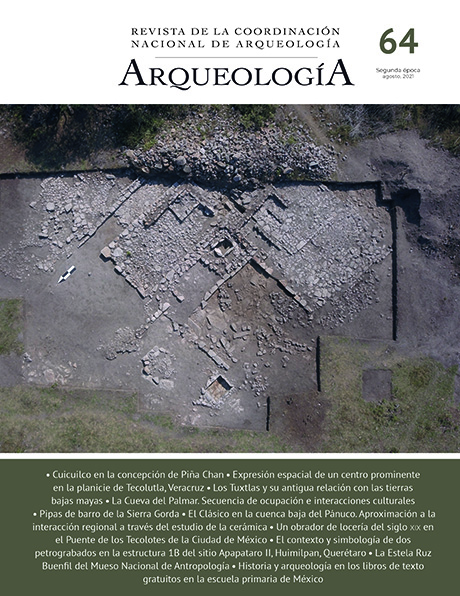La Cueva del Palmar. Secuencia de ocupación e interacciones culturales
Keywords:
Plainview-Golondrina, obsidian, archaic, burials, interactionsAbstract
The excavation of the Cueva del Palmar site, a rock shelter located nearby the town of Huayacocotla, in northeastern Veracruz, has
returned a body of data of pre-ceramic occupations, covering a span of time from the end of the Pleistocene to the late Holocene. These evidences improve the knowledge of early settlements in Mexico and support the idea of a network of relationships between the center-south of the United States and the eastern slope of Mexico. Since the first peopling, the study area was preferred because of its cool and rainy weather and the abundance of biotic and abiotic resources. It’s during the late Archaic when a severe drought caused intergroupal conflicts with violent clashes. The cultural sequence of the site begins about 12,000 ago, at the end of Pleistocene, with the arrival of groups that hunted horse and utilized flint tools. In the early Holocene, new populations carrying Plainview-Golondrina technology settled throughout the region. During the middle and late Archaic, the occupations were longer and more intense; three primary burials, dated to the late Archaic, allow a more precise knowledge of the physical traits and the life conditions of the last hunter-gatherer populations in this area.
Downloads
References
ÁLVAREZ, A. Ma., Cassiano G., y Sánchez, S. (En prensa): Edafología ya: aproximación al cambio ambiental a escala de sitio. Cuicuilco. ENAH-INAH.
ÁLVAREZ, A. Ma., y Cassiano, G. (2013): Cambios de la estructura tecnológica y del patrón de asentamiento en la transición del Pleistoceno-Holoceno. En Mayán Cervantes y Fernando López (coords.), Cambio climático y procesos culturales (pp. 26-49). México, Academia Mexicana de Ciencias Antropológicas.
ÁLVAREZ, A. Ma., y Cassiano, G. (2019): Las pictografías de la región de Huayacocotla, Veracruz: su posición cronológica y relación con la cultura otomí. En Ma. de Lourdes Hernández, Luis A. Montero y María del Pilar Ponce (coords.), El patrimonio arqueológico, histórico y cultural veracruzano: proyectos e investigaciones recientes en el Centro INAH Veracruz (pp. 18-30). México, INAH (Textos de Divulgación).
AMS Laboratory (2016): Rebollo, N (AA107001-AA107010)-Radiocarbon Analitical Report. University of Arizona.
BOUSMAN, B., y Vierra, B. (2012): Chronology, Enviromental Setting and Views of the Terminal Pleistocene and Early Holocene Cultural Transitions in North America. En Britte Bousman y Bradley Vierra (eds.), From Pleistocene to the Holocene. Human Organization and Cultural Transformations in Prehistoric North America (pp. 1-15). Texas A&M, University Press.
CASSIANO, G., y Álvarez, A. Ma. (2007): Poblamiento clovis en la región de Metztitlan, Hidalgo, México. Arqueología, 36: 7-23. México, Dirección de Arqueología-INAH.
CASSIANO, G., y Álvarez, A. Ma (2015): Proyecto la etapa cazadora-recolectora en Veracruz y en México. Informe técnico-parcial, temporada 2014-2015. Archivo Técnico del Consejo de Arqueología-INAH.
CONSERVA, Ma. Elena, y Byrne, R. (2002): Late Holocene Vegetation Change in the Sierra Madre Oriental of Central Mexico. Quaternary Research, 58 (2): 122-129. Cambridge University Press.
FLANNERY, K.V. (1986): Guilá Naquitz. Archaic Foraging and Early Agriculture in Oaxaca, Mexico. Ann Arbor, Michigan, Museum of Anthropology-University of Michigan.
HILLESHEIM, M.B., Hodell, D.A., Leyden, B.W., Brenner, M., Curtis, J.H., Anselmetti, F.S., Ariztegui, D., Buck, D.G., Guilderson, T.P., Rosenmeier M.F., y Schnurrenberger, D.W. (2005): Climate Change in Lowland Central America during the Late Deglacial and Early Holocene. Journal of Quaternary Science, 20 (4): 363-376.
MACNEISH, R.S. (1985): Tehuacan’s Accomplishments. En J.A. Sabloff y V. Bridker (eds.), Supplement. Handbook of Middle American Indians. Vol. I: Archaeology (pp. 345-373). Austin, University of Texas Press.
MACNEISH, R.S., Nelken-Terner, A., y Weitlaner de Johnson, I. (1967): The Prehistory of the Tehuacan Valley. Vol. 2: The Non-Ceramic Artifacts. Austin y Londres, Robert S. Peabody Foundation/ University of Texas Press.
MÁRQUEZ, R.W., y Márquez R., Juan (2009): Municipios con mayor biodiversidad en Veracruz. Foresta Veracruzana, 11 (2): 43-50. Xalapa, Veracruz, Recursos Genéticos Forestales-Universidad Veracruzana.
METCALFE, S.E., O’Hara, S.L., Caballero, M., y Davies, S.R. (2000): Records of Late Pleistocene-Holocene Climatic Change in Mexico. A Review. Quaternary Science Reviews, 19: 699-721.
MEZA, M. (2015): Informe preliminar de los materiales óseos humanos del abrigo Cueva del Palmar (anexo 1). En G. Cassiano y A. Ma. Álvarez, Proyecto la Etapa Cazadora-recolectora en Veracruz y en México. Informe técnico parcial, temporada 2013-2014. México. Archivo Técnico del Consejo Arqueología-INAH.
MONROY, R.C. (1996): Índice de sitio para Pinus patula Schl. et Cham. en la región de Huayacocotla, estado de Veracruz. Ciencias Forestales, 21 (80): 21.
OLIVEROS, A., y Cassiano, G. (2003): El pasado del pasado. Artefacto prehistórico en una tumba de El Opeño, Michoacán. Arqueología, 29: 31-44. México, Coordinación Nacional de Arqueología-INAH.
RAMÍREZ, F., y Palma, J. (1980): Proyecto para una Reserva Ecológica en Huayacocotla, Ver. Xalapa, Veracruz, México, Instituto Nacional de Investigaciones sobre Recursos Bióticos. Ms.
REBOLLO, N. (2015): Reporte preliminar del muestreo diagnóstico de los restos óseos de la Cueva del Palmar para su datación por radiocarbono (anexo 2). En G. Cassiano y A. Ma. Álvarez, Proyecto la Etapa Cazadora-recolectora en Veracruz y en México. Informe técnico parcial, temporada 2013-2014. México, Archivo Técnico del Consejo Arqueología-INAH.
Robles, E. (2015): Informe del análisis del material arqueozoológico del Proyecto La Cazadora-recolectora en Veracruz y en México (anexo 3). En G. Cassiano y A. Ma. Álvarez, Proyecto la Etapa Cazadora-recolectora en Veracruz y en México. Informe técnico parcial, temporada 2014-2015. Archivo Técnico del Consejo de Arqueología-INAH.
TURNER, E.S., Hester, T.R., y McReynolds, R.L. (2011): Stone Artifacts of Texas Indians. Lanham, Taylor Trade Publishing.
WALDORF, V., y Waldorf, D.C. (1987): Story in Stone. Flint Types of the Central and Southern U.S. Branson, Missouri, Mound Builder Books.
WILKERSON, S.J.K. (1973): Ethnogenesis of the Huastec and Totonacs: Early Cultures of North-Central Veracruz at Santa Luisa, Mexico. Tesis de Doctorado en Antropología. Tulane University, Louisiana.



